Preparation and Short-Term Aging Properties of Asphalt Modified by Novel Sustained-Release Microcapsules Containing Rejuvenator
Abstract
:1. Introduction
2. Materials and Methods
2.1. Raw Materials
2.2. Preparation of Sustained-Release Microcapsules
2.3. Preparation and Aging Test of Microcapsule-Modified Asphalt
2.4. Characterization of Microcapsules
2.5. Characterization Methods of Asphalt
3. Results and Discussion
3.1. Coating Ratio of Microcapsules
3.1.1. Effects of Different Emulsifiers
3.1.2. Effects of Core/Shell Mass Ratios
3.2. Sustained-Release Performance of Microcapsules
3.2.1. Morphology Analyses
3.2.2. Sustained-Release Performance
3.3. Physical Properties of Different Asphalt after Aging
3.3.1. Penetration, Softening Point, and Ductility of Asphalt
3.3.2. Brookfield Viscosity of Asphalt
3.3.3. Viscoelasticity of Microcapsule-Modified Asphalt
4. Conclusions
- (1)
- The sustained-release microcapsules with a high coating rate can be obtained when sodium dodecyl sulfate (SDS) is used as the emulsifier, and the core/shell mass ratio is 1:1.3. The microcapsules are in complete encapsulation with an average particle size of 60 μm and a smooth surface observed by SEM.
- (2)
- The prepared microcapsules have good thermal stability in the range below 130 °C. Upon further increasing the temperature to 140 °C, the shell surface morphology of the microcapsules becomes coarser, indicating a large number of micropore structures in the shell of the microcapsules. The microporous structure provides favorable conditions for the release of the rejuvenator in asphalt.
- (3)
- In contrast to the 44% mass loss rate of rejuvenator at 185 °C for 4 h, the mass loss rate of rejuvenator coated in microcapsules is only 26% under the same conditions. The release rate of rejuvenator is obviously slowed down by the microcapsules, exhibiting obvious slow release characteristics.
- (4)
- The penetration ratio of microcapsule-modified asphalt after aging is higher than that of original asphalt after aging; the softening point increment of the microcapsule-modified asphalt after aging is lower than that of the original asphalt; the ductility ratio of the microcapsule-modified asphalt is far higher than that of the original asphalt. These results indicate that the addition of sustained-release microcapsules could obviously improve the anti-aging properties of asphalt.
- (5)
- Viscosity aging index and DSR test results show that asphalt modified by sustained-release microcapsules containing rejuvenator possesses excellent anti-aging properties. It is very useful to apply these novel sustained-release microcapsules to modify asphalt and improve its anti-aging ability.
Author Contributions
Funding
Conflicts of Interest
References
- Lesueur, D. The colloidal structure of bitumen: Consequences on the rheology and on the mechanisms of bitumen modification. Adv. Colloid. Interf. Sci. 2009, 145, 42–82. [Google Scholar] [CrossRef] [PubMed]
- Pan, P.; Wu, S.; Yue, X.; Gang, L. A review on hydronic asphalt pavement for energy harvesting and snow melting. Renew. Sust. Energ. Rev. 2015, 48, 624–634. [Google Scholar] [CrossRef]
- Saoula, S.; Soudani, K.; Haddadi, S.; Munoz, M.E.; Santamaria, A. Analysis of the rheological behavior of aging bitumen and predicting the risk of permanent deformation of asphalt. Mater. Sci. Appl. 2013, 4, 312–318. [Google Scholar]
- Garcíaa, Á. Self-healing of open cracks in asphalt mastic. Fuel 2012, 93, 264–272. [Google Scholar] [CrossRef]
- Gao, J.; Guo, H.; Wang, X.; Wang, P.; Wei, Y.; Wang, Z.; Huang, Y.; Yang, B. Microwave deicing for asphalt mixture containing steel wool fibers. J. Clean. Prod. 2019, 206, 1110–1122. [Google Scholar] [CrossRef]
- Al-Rub, R.K.A.; Darabi, M.K.; Little, D.N.; Masad, E.A. A micro-damage healing model that improves prediction of fatigue life in asphalt mixes. Int. J. Eng. Sci. 2010, 48, 966–990. [Google Scholar] [CrossRef]
- Shen, J.; Amirkhanian, S.; Aune Miller, J. Effects of rejuvenating agents on superpave mixtures containing reclaimed asphalt pavement. J. Mater. Civ. Eng. 2007, 19, 376–384. [Google Scholar] [CrossRef]
- Elseifi Alqadi, M.; Carpenter, S.H. Reclaimed Asphalt Pavement—A Literature Review; Illinois Center for Transportation: Rantoul, IL, USA, 2007. [Google Scholar]
- Li, R.; Zhou, T.; Pei, J. Design, preparation and properties of microcapsules containing rejuvenator for asphalt. Constr. Build. Mater. 2015, 99, 143–149. [Google Scholar] [CrossRef]
- Su, J.F.; Schlangen, E.; Qiu, J. Design and construction of microcapsules containing rejuvenator for asphalt. Powder. Technol. 2013, 235, 563–571. [Google Scholar] [CrossRef]
- Garcíaa, Á.; Schlangen, E.; Ven, M.; Sierra-Beltrána, G. Preparation of capsules containing rejuvenators for their use in asphalt concrete. J. Hazard. Mater. 2010, 184, 603–611. [Google Scholar] [CrossRef] [PubMed]
- Sun, D.; Tong, L.; Zhu, X.; Li, B.; Yang, T. Optimization of synthesis technology to improve the design of asphalt self-healing microcapsules. Constr. Build. Mater. 2018, 175, 88–103. [Google Scholar] [CrossRef]
- Lv, L.; Yang, Z.; Chen, G.; Zhu, G.; Han, N.; Schlangen, E.; Xing, F. Synthesis and characterization of a new polymeric microcapsule and feasibility investigation in self-healing cementitious materials. Constr. Build. Mater. 2016, 105, 487–495. [Google Scholar] [CrossRef]
- Su, J.F.; Wang, Y.Y.; Han, N.X.; Yang, P.; Han, S. Experimental investigation and mechanism analysis of novel multi-self-healing behaviors of bitumen using microcapsules containing rejuvenator. Constr. Build. Mater. 2016, 106, 317–329. [Google Scholar] [CrossRef]
- Aguirre, M.A.; Hassan, M.M.; Shirzad, S.; Daly, W.H.; Mohammad, L.N. Micro-encapsulation of asphalt rejuvenators using melamine-formaldehyde. Constr. Build. Mater. 2016, 114, 29–39. [Google Scholar] [CrossRef]
- Xue, B.; Wang, H.F.; Pei, J.Z.; Li, R.; Zhang, J.P.; Fan, Z.P. Study on self-healing microcapsule containing rejuvenator for asphalt. Constr. Build. Mater. 2017, 135, 641–649. [Google Scholar] [CrossRef]
- Zhang, H.L.; Bai, Y.Z.; Cheng, F.L. Rheological and self-healing properties of asphalt binder containing microcapsules. Constr. Build. Mater. 2018, 138, 138–148. [Google Scholar] [CrossRef]
- Sun, D.Q.; Li, B.; Tian, Y.; Lu, T.; Zhu, X.Y.; Sun, G.Q.; Gilabert, F.A. Aided regeneration system of aged asphalt binder based on microcapsule technology. Constr. Build. Mater. 2019, 201, 571–579. [Google Scholar] [CrossRef]
- ASTM D5/D5M-13, Standard Test Method for Penetration of Bituminous Materials; ASTM International: West Conshohocken, PA, USA, 2013.
- ASTM D113-17, Standard Test Method for Ductility of Asphalt Materials; ASTM International: West Conshohocken, PA, USA, 2017.
- ASTM D36-06, Standard Test Method for Softening Point of Bitumen (Ring-and-Ball Apparatus); ASTM International: West Conshohocken, PA, USA, 2006.
- Wang, H.L.; Liu, S.Q.; Zhang, X.Y. Preparation and application of sustained release microcapsules of potassium ferrate(VI) for dinitro butyl phenol (DNBP) wastewater treatment. J. Hazard. Mater. 2009, 169, 448–453. [Google Scholar] [CrossRef] [PubMed]
- STM D4402-06, Standard Test Method for Viscosity Determination of Asphalt at Elevated Temperatures Using a Rotational Viscometer; ASTM International: West Conshohocken, PA, USA, 2006.
- Hsieh, W.C.; Chang, C.P.; Gao, Y.L. Controlled release properties of chitosan encapsulated volatile ctronella oil microcapsules by thermal treatments. Colloid. Surf. B 2006, 53, 209–214. [Google Scholar] [CrossRef] [PubMed]
- Teeka, P.; Chaiyasat, A.; Chaiyasat, P. Preparation of poly (methyl methacrylate) microcapsule with encapsulated jasmine oil. Energy Procedia 2014, 56, 181–186. [Google Scholar] [CrossRef]
- Legrand, J.; Brujes, L.; Garnelle, G. Study of a microencapsulation process of a virucide agent by a solvent evaporation technique. J. Microencapsul. 1995, 12, 11–17. [Google Scholar] [CrossRef] [PubMed]
- Shin, M.J.; Shin, Y.J.; Hwang, S.W.; Shin, J.S. Microencapsulation of imidazole curing agent by solvent evaporation method using W/O/W emulsion. J. Appl. Polym. Sci. 2013, 129, 1036–1044. [Google Scholar]
- Assimopoulou, A.N.; Papageorgiou, V.P.; Kiparissides, C. Synthesis and release studies of shikonin-containing microcapsules prepared by the solvent evaporation method. J. Microencapsul. 2010, 20, 581–596. [Google Scholar] [CrossRef]
- Kirkby, E.L.; Michaud, V.J.; Manson, J.E.; Sottos, N.R.; White, S.R. Performance of self-healing epoxy with microencapsulated healing agent and shape memory alloy wires. Polymer 2009, 50, 5533–5538. [Google Scholar] [CrossRef]
- Siddiqui, M.N.; Ali, M.F. Investigation of chemical transformations by NMR and GPC during the laboratory aging of Arabian asphalt. Fuel 1999, 78, 1407–1416. [Google Scholar] [CrossRef]
- Herold, M.; Roberts, D. Spectral characteristics of asphalt road aging and deterioration: Implications for remote-sensing applications. Appl. Opt. 2005, 44, 4327–4334. [Google Scholar] [CrossRef] [PubMed]
- Xiang, L.; Cheng, J.; Kang, S. Thermal oxidative aging mechanism of crumb rubber/SBS composite modified asphalt. Constr. Build. Mater. 2015, 75, 169–175. [Google Scholar] [CrossRef]
- Praticò, F.G.; Casciano, A.; Tramontana, D. Pavement life-cycle cost and asphalt binder quality: A theoretical and experimental investigation. J. Constr. Eng. Manag. 2011, 137, 99–107. [Google Scholar] [CrossRef]
- Kim, Y.R.; Lee, J. Performance-Based Analysis of Polymer-Modified Emulsions in Asphalt Surface Treatments; FHWA/NC/2007-06; US Transportation Collection: Washington, DC, USA, 2009. [Google Scholar]
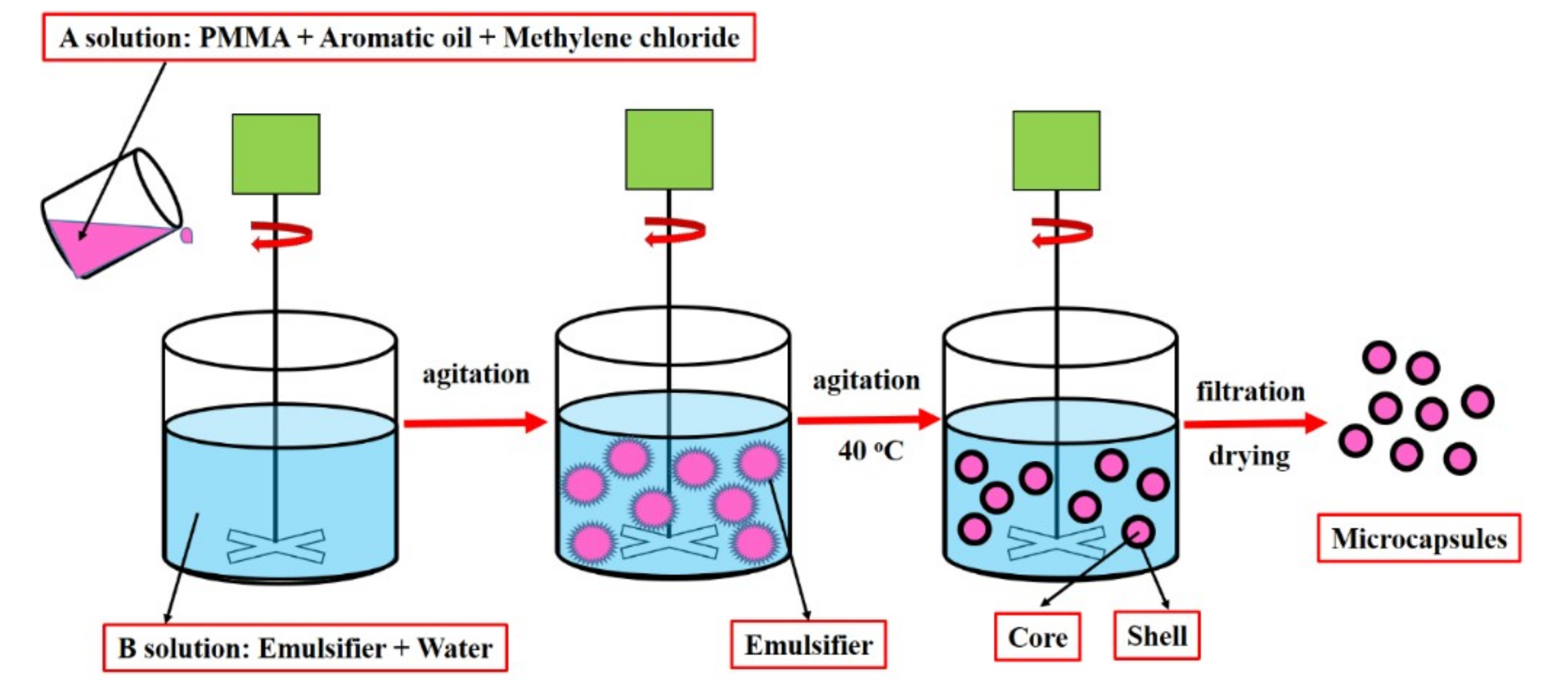

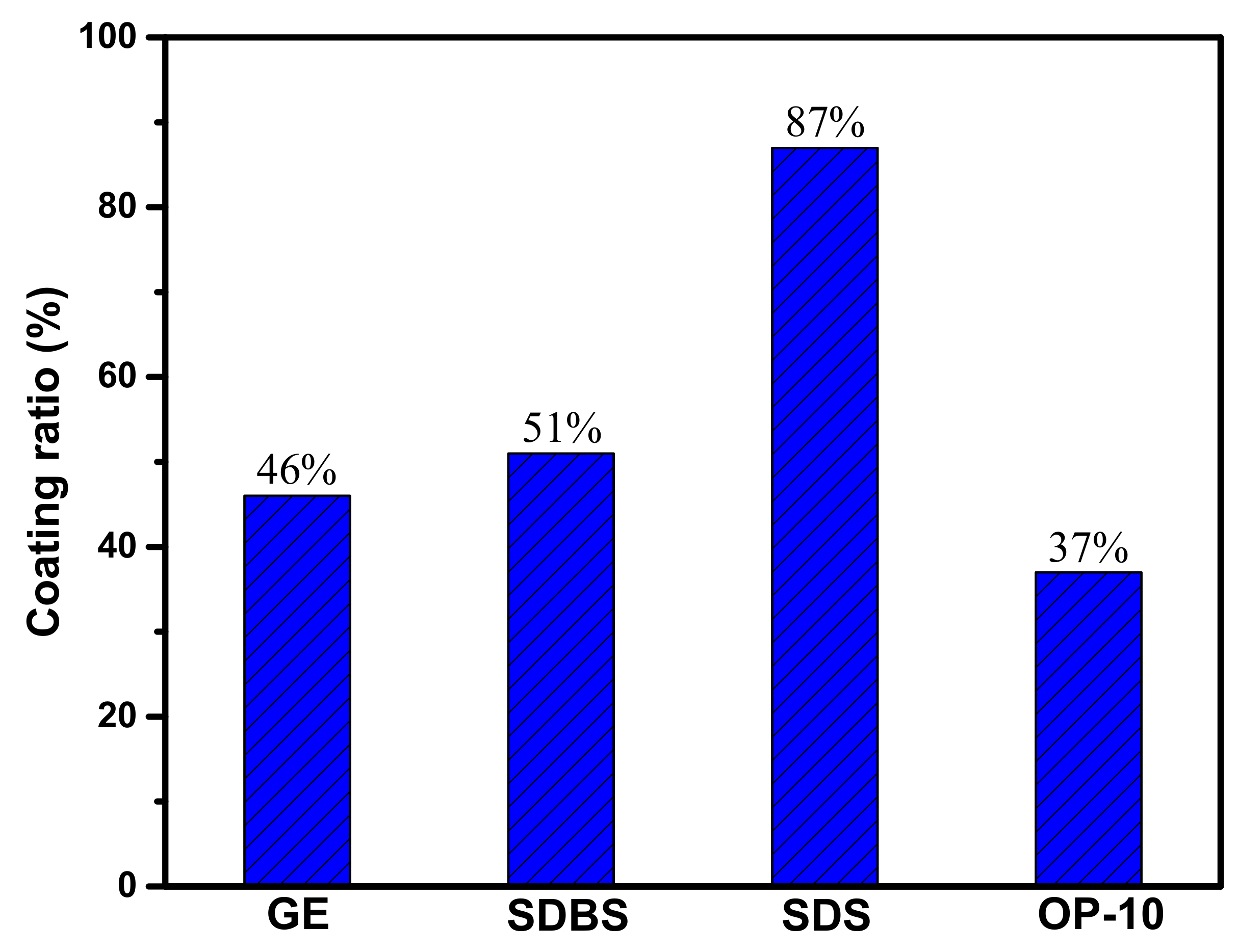
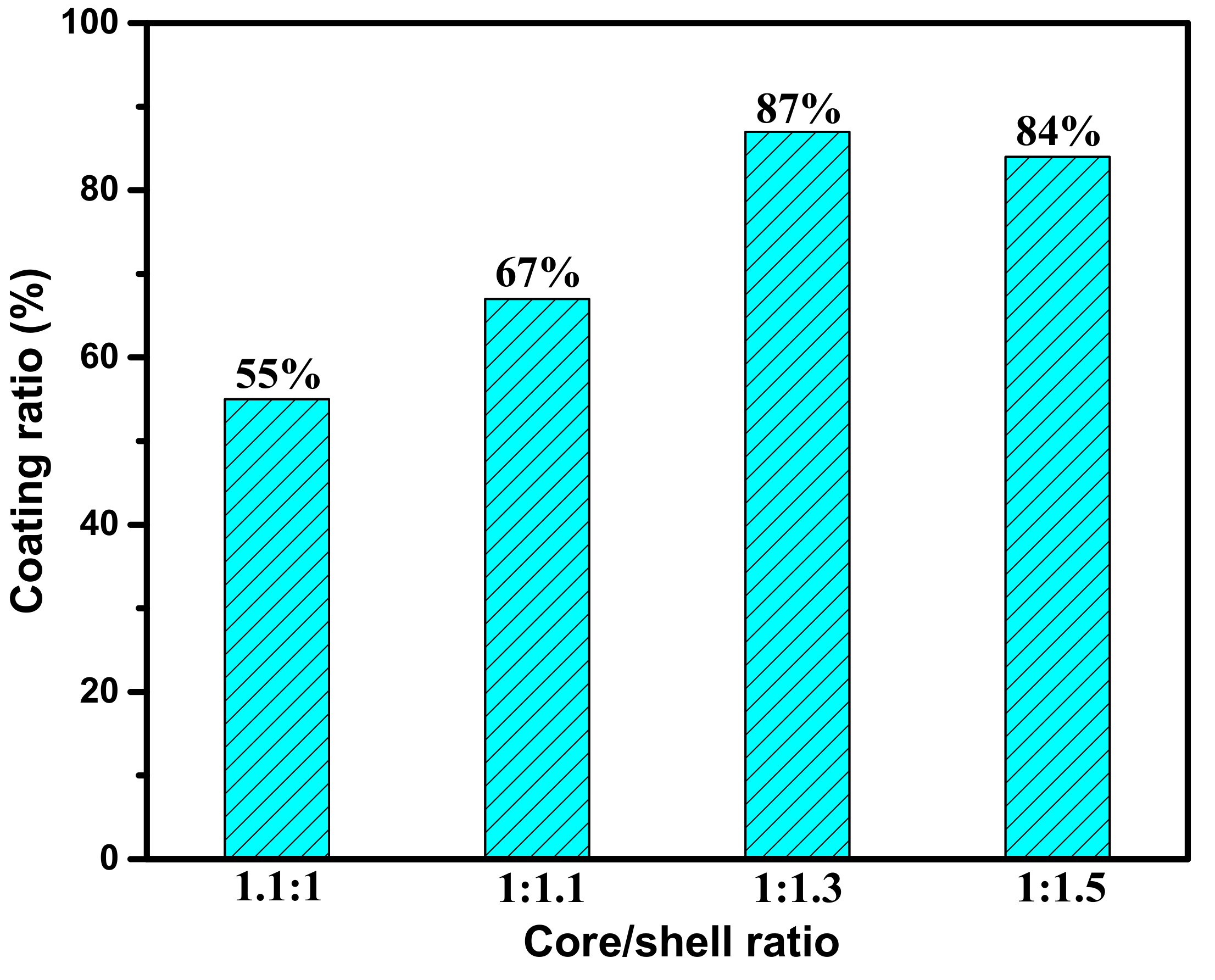
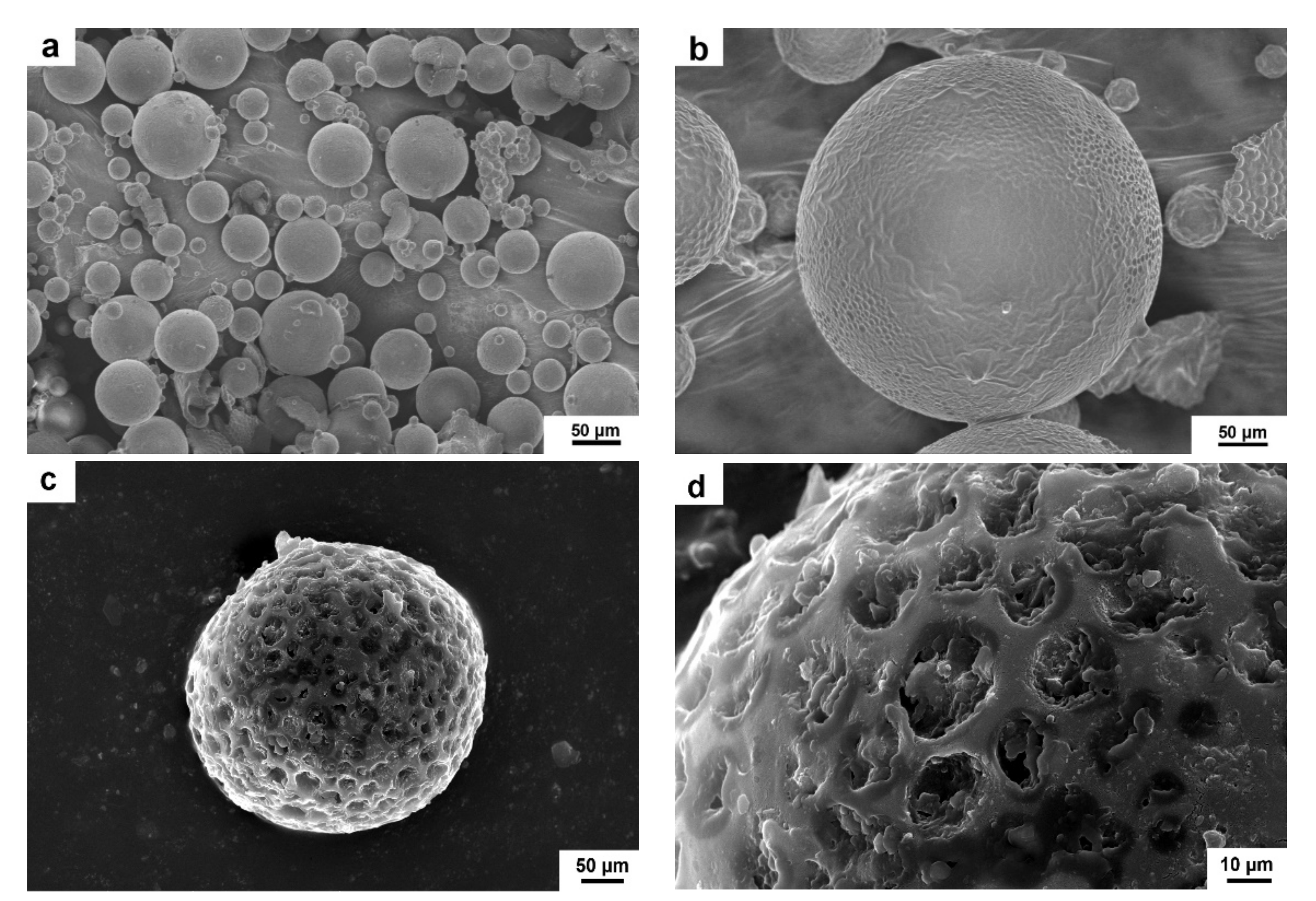
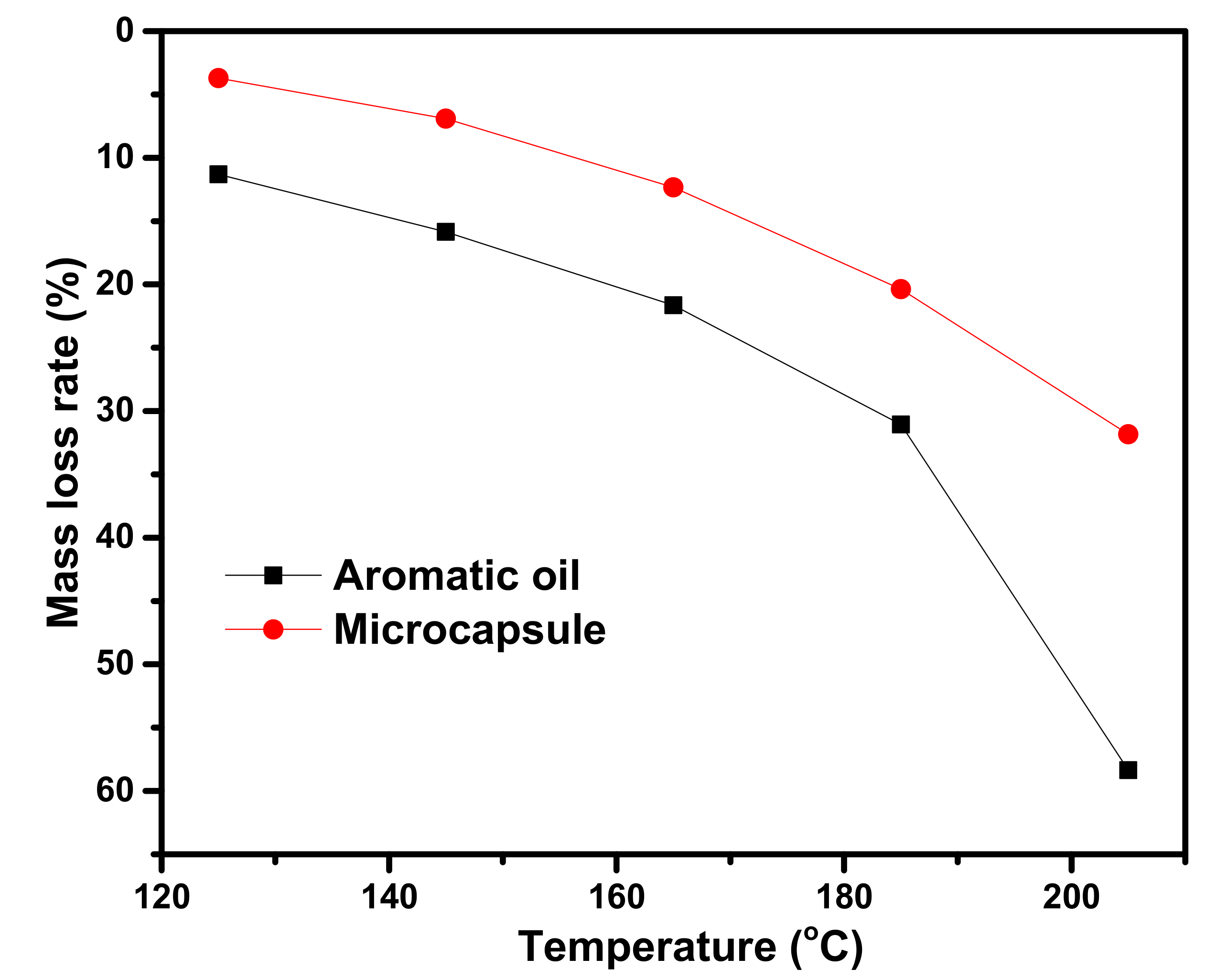
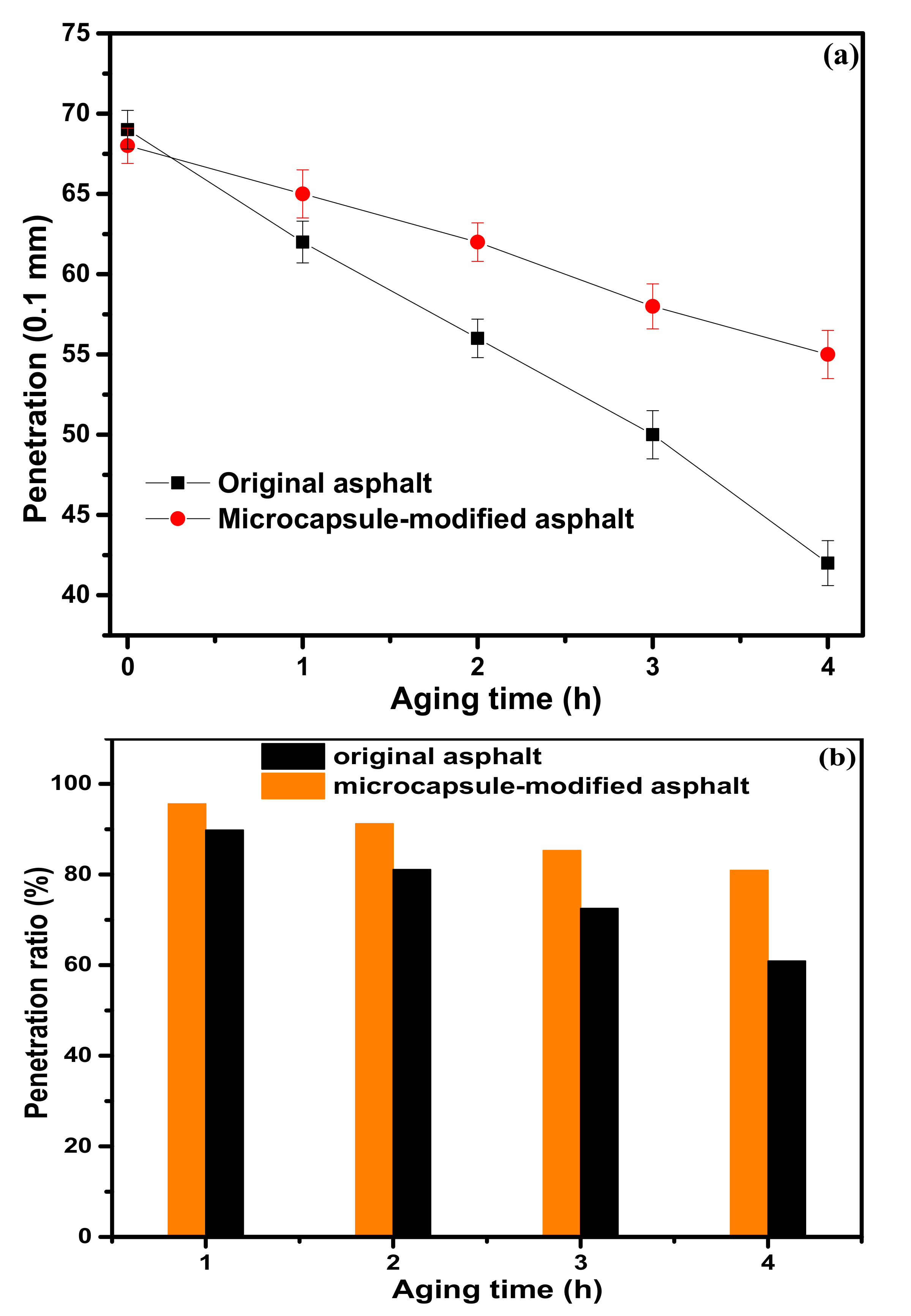
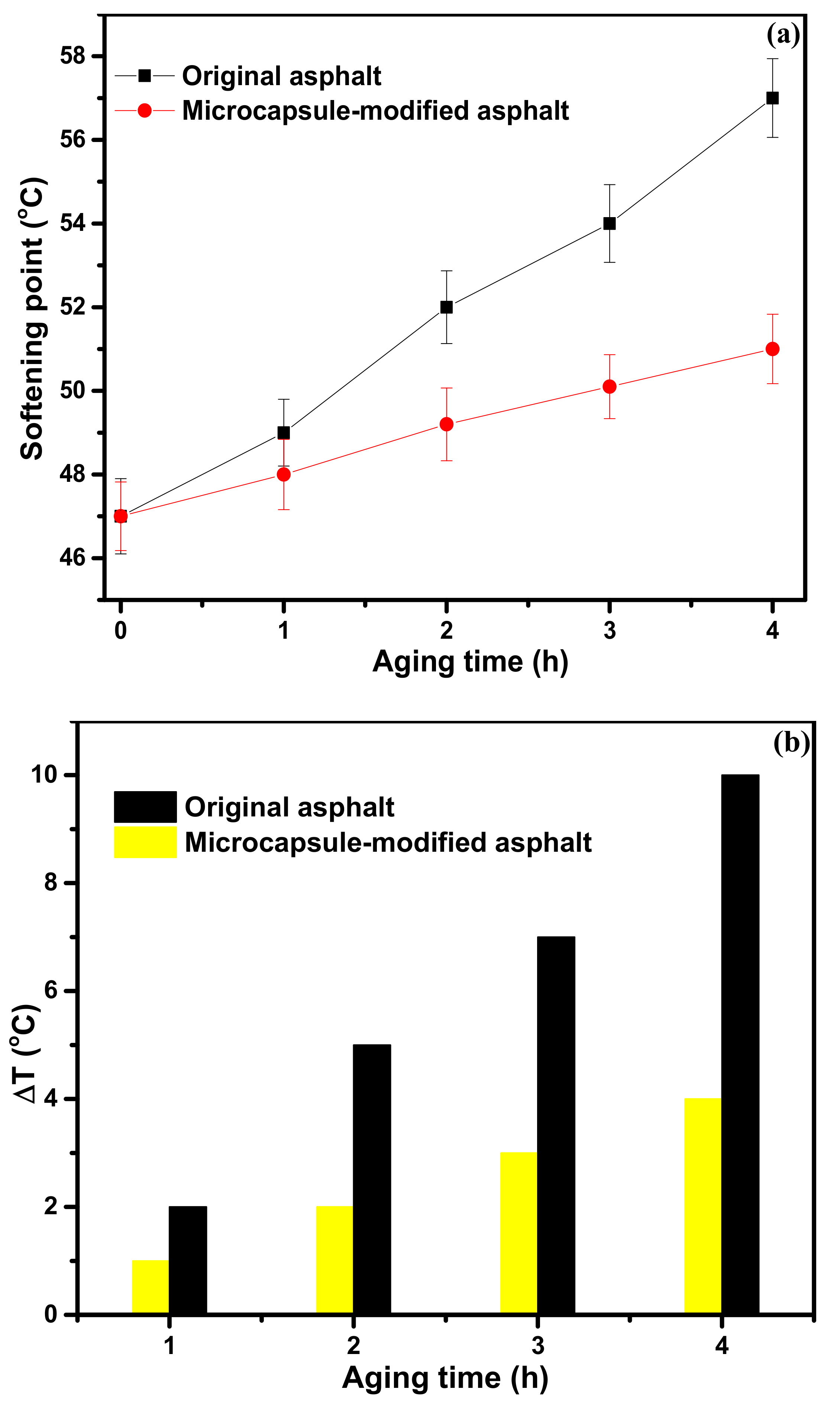
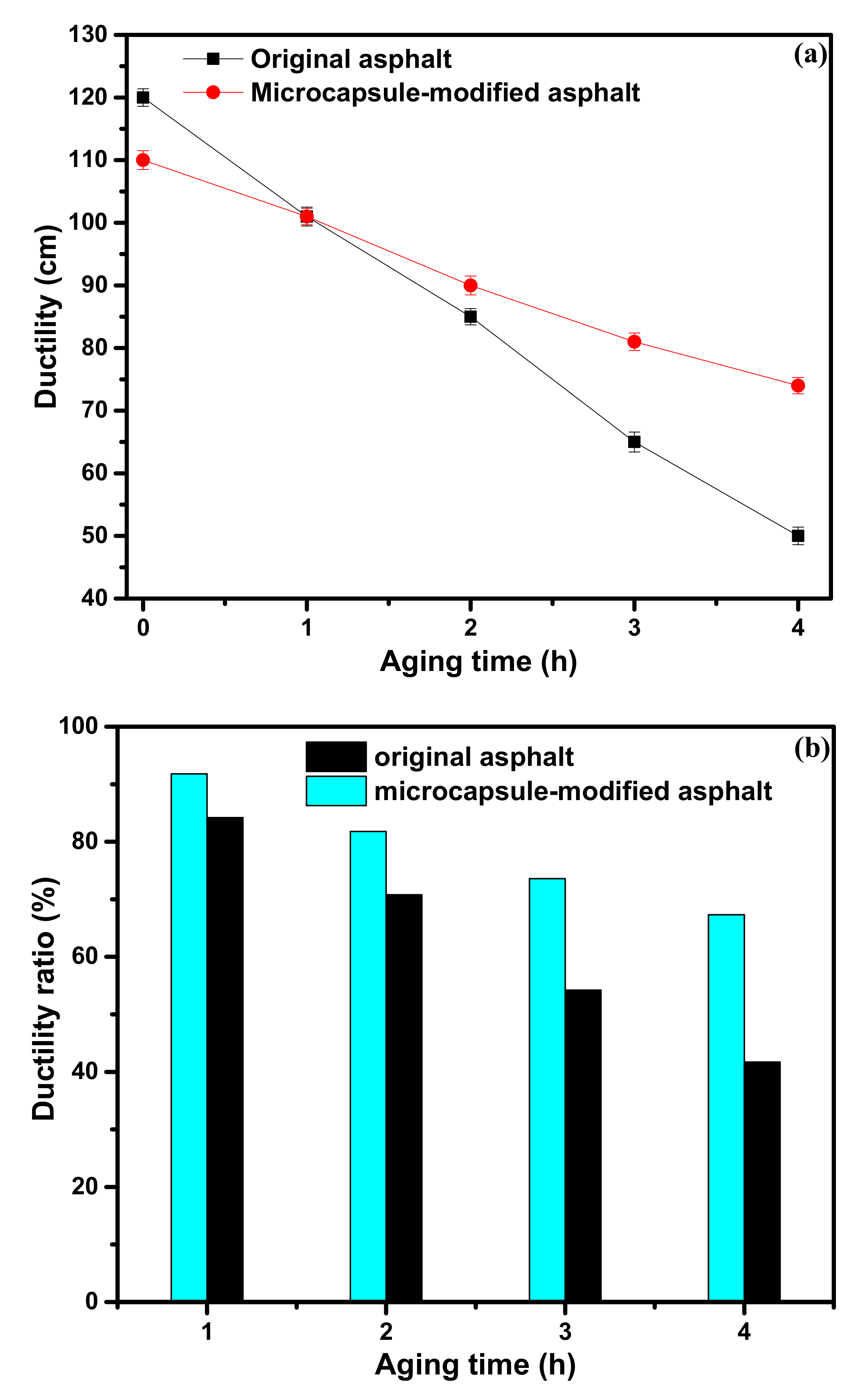
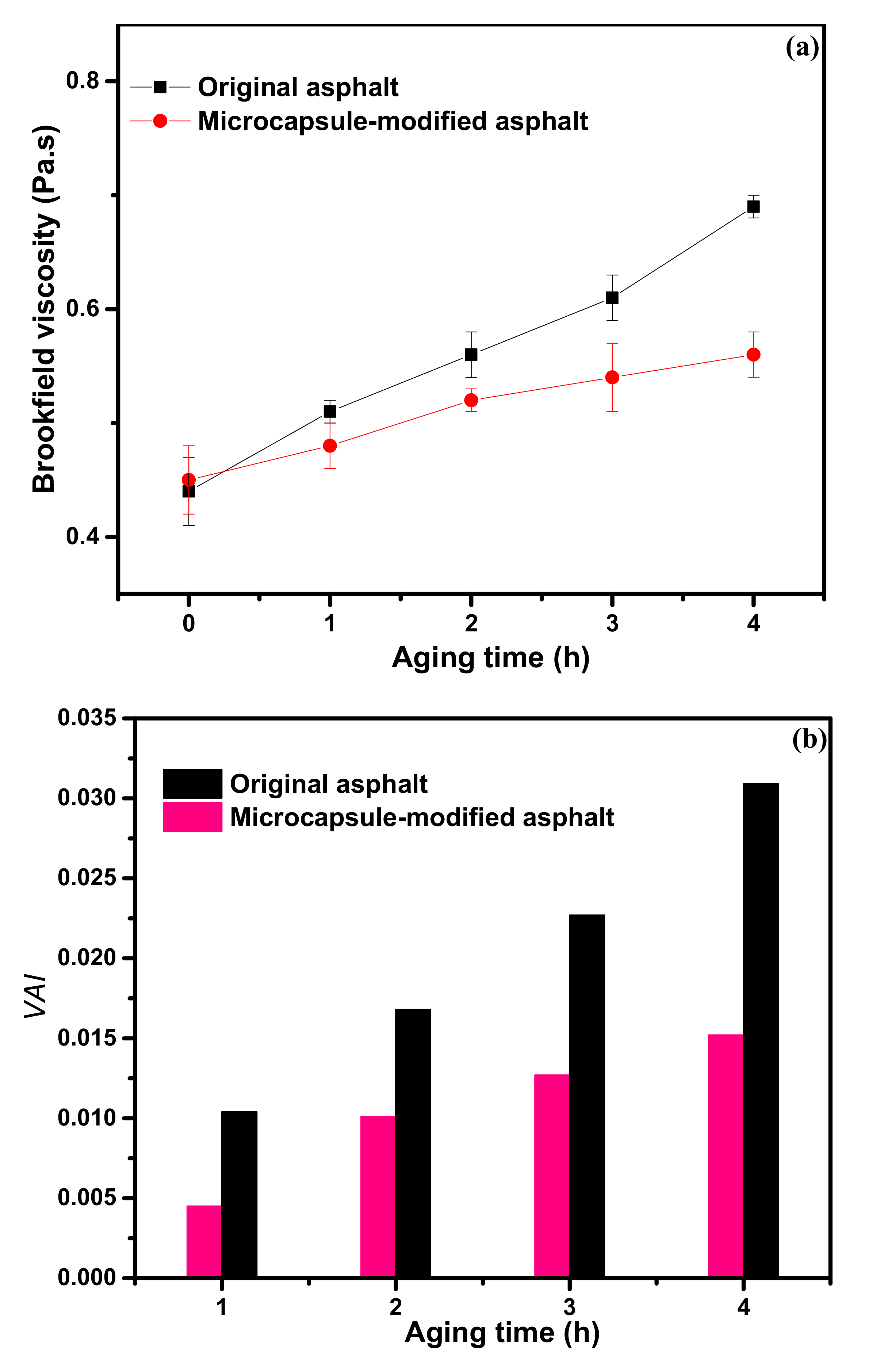
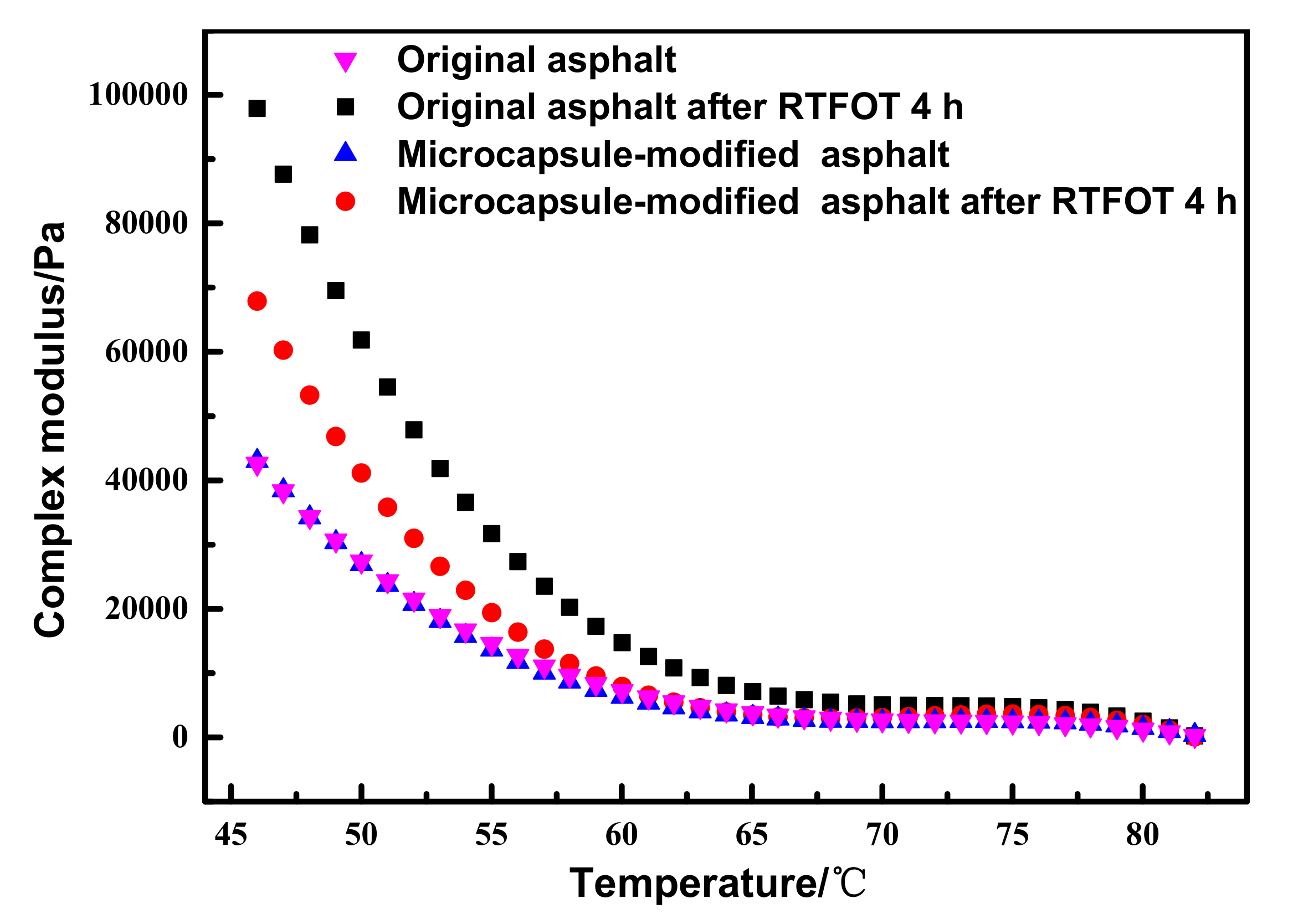
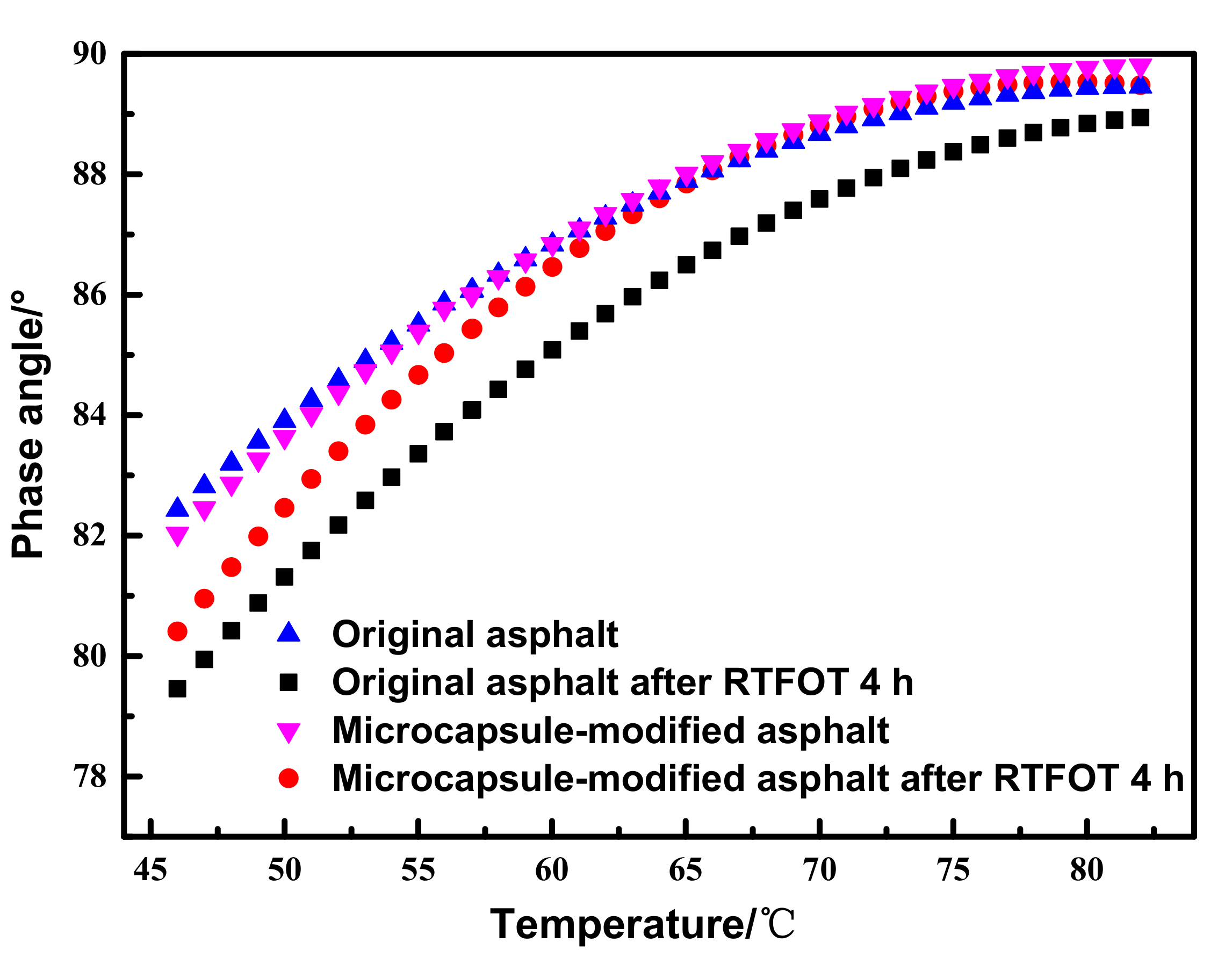
| Properties | Results | Specification | |
|---|---|---|---|
| Original Asphalt | Modified Asphalt | ||
| Penetration (25 °C, 100 g, 5 s) (0.1 mm) | 69 | 68 | 60–80 (ASTM D5) [19] |
| Ductility (15 °C, 5 cm/min) (cm) | 120 | 110 | ≥100 (ASTM D113) [20] |
| Softening point (°C) | 47 | 47 | ≥40 (ASTM D36) [21] |
| Density (25 °C) (g/cm3) | 1.038 | – | – |
© 2019 by the authors. Licensee MDPI, Basel, Switzerland. This article is an open access article distributed under the terms and conditions of the Creative Commons Attribution (CC BY) license (http://creativecommons.org/licenses/by/4.0/).
Share and Cite
Yan, X.; Ning, G.; Wang, X.; Ai, T.; Zhao, P.; Wang, Z. Preparation and Short-Term Aging Properties of Asphalt Modified by Novel Sustained-Release Microcapsules Containing Rejuvenator. Materials 2019, 12, 1122. https://doi.org/10.3390/ma12071122
Yan X, Ning G, Wang X, Ai T, Zhao P, Wang Z. Preparation and Short-Term Aging Properties of Asphalt Modified by Novel Sustained-Release Microcapsules Containing Rejuvenator. Materials. 2019; 12(7):1122. https://doi.org/10.3390/ma12071122
Chicago/Turabian StyleYan, Xin, Guotao Ning, Xiaofeng Wang, Tao Ai, Peng Zhao, and Zhenjun Wang. 2019. "Preparation and Short-Term Aging Properties of Asphalt Modified by Novel Sustained-Release Microcapsules Containing Rejuvenator" Materials 12, no. 7: 1122. https://doi.org/10.3390/ma12071122
APA StyleYan, X., Ning, G., Wang, X., Ai, T., Zhao, P., & Wang, Z. (2019). Preparation and Short-Term Aging Properties of Asphalt Modified by Novel Sustained-Release Microcapsules Containing Rejuvenator. Materials, 12(7), 1122. https://doi.org/10.3390/ma12071122




